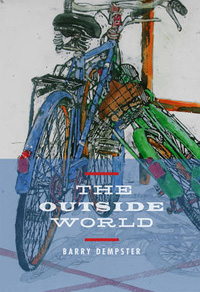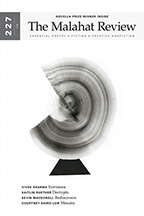Reviews
Fiction Review by Jamie Dopp
Barry Dempster, The Outside World (St. John's: Pedlar, 2013). Paperbound, 184 pp., $22.
 Suburbs promise the benefits of big city life without the problems. In the suburbs, you can supposedly have the conveniences of modern life but also a big yard, a quiet street, and a sense of isolation from the outside world. The promise of the suburbs is, of course, a fantasy. As Barry Dempster puts it in his short story "Writing Home," compared to Jarvis Street in Toronto a middle class cul de sac in Scarborough might seem "like paradise," but it remains, in fact, "a piece… of the everyday universe."
Suburbs promise the benefits of big city life without the problems. In the suburbs, you can supposedly have the conveniences of modern life but also a big yard, a quiet street, and a sense of isolation from the outside world. The promise of the suburbs is, of course, a fantasy. As Barry Dempster puts it in his short story "Writing Home," compared to Jarvis Street in Toronto a middle class cul de sac in Scarborough might seem "like paradise," but it remains, in fact, "a piece… of the everyday universe."
In his recent novel The Outside World, Dempster returns to his own roots in Scarborough—or Scarberia, as it is not so affectionately known—to tell the coming-of-age story of Robby Tedley, who, at age fourteen, faces a series of crises: his father has a heart attack and responds, upon recovery, by spending as much time as possible away from the family building a cottage on a lake; his mother is increasingly agoraphobic; and his mentally challenged sister, without parental supervision, begins to roam the streets. The family crises bring interventions from various members of the extended family—all of which create more problems for Robby to deal with. In addition to family issues, Robby has to deal with a bullying boy next door whose own father is dying from cancer, as well as, not surprisingly, his own raging hormones: amongst other things, he has a crush on a girl at school named Wendy.
The coming-of-age challenges faced by Robby are familiar novelistic territory, but Dempster brings life to them with some fine writing. The Outside World has qualities similar to Dempster's fourteen books of poetry—a kind of unpretentious lyricism, well-crafted images accompanied by natural-seeming rhythms and lines, as well as occasional, admirable philosophical depths. Take this description of the Tedley house from early on: "Our house ticked softly, as if the clock were counting down the minutes until time disappeared. A steam iron hissed over a peach-coloured pillow slip. The Secret Stormstory unfolded on the rec room TV in sudden swells of melodramatic music. Everything was in its place, me curled up in the worn leather armchair, Lissy lying on the rug half-buried beneath her collection of stuffed animals." This passage helps to establish the "false paradise" of the Tedley home. The allusion to the soap opera The Secret Storm is partly a period detail (the novel takes place in 1966) and partly a sly comment on the melodramatic storm soon to overtake the Tedleys.
The novel itself proceeds in a series of short, vivid scenes, which moves the story forward briskly. This creates something like the effect of memory: how someone who was fourteen years old almost half a century ago would remember a year of vivid events. There are also quite a few funny moments, mostly dealing with the sexual and scatological themes that tend to preoccupy teenage boys. I found myself cringing and laughing at the same time on a number of occasions (like the scene in which Robby and his friend collect up all the dog shit in the neighbourhood for an elaborate act of revenge on the bully). The most interesting part of the novel, though, is the way the central story line about the mother's illness intersects with the exploration of the false paradise of the suburbs. Agoraphobia is, by definition, a fear of the "outside." Mrs.Tedley's extreme fears of leaving the house are revealed, over the course of the novel, to be an exaggerated response to the uncertainties everyone must face in life. As the story proceeds, more and more of the burden of handling Mrs. Tedley and her phobia falls on Robby. The stress leads him into his own anxiety / depression and raises the spectre that, in his mother's madness, he is seeing himself in the future. "What did people see when they looked at me?" he asks himself. "Relatives had remarked that I was like my mother—what did they mean? . . . Was there a part of me that would one day fall apart?" Eventually, in his desperation, Robby tries to force his mother out of the house to face "the real world"—which leads to a near catastrophe and her subsequent institutionalization at 999 Queen Street West in Toronto.
At the end of the novel, various plotlines—including that of Mrs. Tedley—are partially resolved, some for worse and some for better (spoiler alert: after various awkward preliminaries, Robby does get to kiss Wendy!), but nothing is fully "solved," just as the suburbs don't "solve" the problem of having to live with the uncertainties of the outside world. As Robby puts it: "reality happens, for better or worse."
—Jamie Dopp









